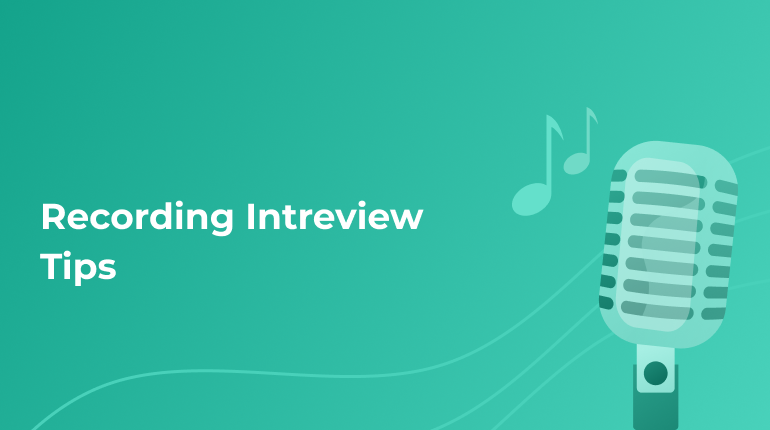Useful Recording Interview Tips and Tricks for Everyone

An interview can be understood in a broad and narrow sense. In the broad sense, an interview is the genre of journalism, a journalist’s conversation with one or more people, which takes place in a free manner to find out new information, establish details, determine someone’s reaction to an event. In the narrow sense, an interview is a method of obtaining information from a person during a live dialogue (face-to-face conversation), when a specially trained performer (interviewer) asks questions guided by a specific goal and specific communication tactics. The person interviewed is called the respondent.
An interview’s value is not simply finding out information that can be obtained from other sources, but in live communication with people, which allows learning about their point of view, assessment of certain events, and the reasons for actions. The interview should also reflect the individual, unique features of the people, their characters, and behavior. In order to achieve this goal, the interviewer must properly construct the questions, that is, apply a creative approach to their formation.
In the interview genre, the journalist-interviewer’s creativity can manifest itself both during and after the interview, in various forms, as the level of the interviewer’s abilities is of great importance for achieving the goal of the interview. A journalist who interviews shows business stars, actors, politicians, etc., first of all, tries to get sensational facts. Thus, in journalism, information that has a sensational or intriguing meaning is valued. We also meet interviews in our daily lives.
For example, the doctor, interviewing the patient, tries to establish the causes of the disease. And the more accurate the patient’s answers, the easier it will be for the doctor to diagnose or prescribe medication. In this case, the value of the information obtained lies in its accuracy. The criminal investigation officer interviews the witness or suspect in order to obtain the information necessary to solve the crime. The data received by the militiaman should be true and as complete as possible.
Try Voice-to-Text Transcription
Try NowBasic Types of Interviews
When choosing the type of interview, you should be guided by its main tasks. Depending on the degree of freedom of the interlocutor, the interview is divided into:
- Free – a conversation that lasts several hours according to the general program but without strict details. The interviewer may ask the questions he or she deems necessary, in any wording or sequence;
- Semi-standardized (focused) interview uses the so-called interview guide, which contains a list of both mandatory and possible questions;
- Standardized – it is carried out according to a detailed plan that specifies the content, sequence of questions, and possible answers. The answers are strictly fixed.
What Equipment Is Needed for Effective Recording?
Modern technology provides a wide range of opportunities for the most adequate recording of conversations with people. When choosing a technique, you should take into account your own financial capabilities and the seriousness of your research. In the case of research based on a large number of interviews, you should use a specially designed digital or cassette recorder (keep in mind that the latter can be designed for both a regular audio cassette that can be listened to on any cassette recorder and a microcassette that can only be listened to with the same microcassette recorder).
You can also use a digital voice recorder, which is available on many modern mobile phones. We should not forget about the possibility of using cassette recorders with built-in microphones. The recording quality is much better than using a remote microphone, which should be placed as close as possible to the respondent, but, of course, so that it does not create a feeling of discomfort.
Professional Recording Equipment
Thus, the above equipment is more suitable for researchers, copywriters, doctors, and other people who do not record interviews on a regular basis but in individual cases. Below is information about some equipment that professional reporters can’t do without.
A voice recorder is considered to be the main equipment for recording a professional interview. Each recorder has standard buttons for recording/playback devices: Start, Stop, Rewind, Record. Some models also have additional buttons, such as Recycle Bin, Playlist, etc. The professional recorder also has a built-in micro-program. The software includes a list of audio files, recording and control settings, and/or the most necessary forms of editing.
In almost all modern voice recorders, you can create a folder, assign it a name (date), configure the sorting of files inside (by duration, by name), and receive information about memory. You can find the quality control of the recorded material in the recording settings: Low, Mid, High Quality. File management and editing, rewinding, cropping, tagging, software conversion to another format are available.
SONY digital voice recorders are well suited for recording. Their main technical characteristics: built-in memory from 1 GB, maximum recording time of 287 hours, listening to MP3 files, USB connection, microphone sensitivity adjustment.
You can also use a hand-held windscreen microphone for better recording. There are 2 types of microphones – headsets with a folding microphone and microphones separately. Headset – the cheapest and worst option. Devices in this class should only be considered as media positioned for applications such as Skype. Minus – the microphone is very close to your mouth. The foam cover that covers the microphone (pop filter) is unlikely to protect the recording from parasitic noise. Muttering and exhalation will be well heard.
Microphones are condenser and dynamic. Both have a number of advantages and disadvantages. Dynamic – cheaper, inferior to the condenser recording quality, but win in practicality and unpretentiousness to noise. Condenser microphones are the most common in professional studios; they have excellent characteristics, but at the same time, need a well-designed in terms of acoustics room (studio).
A desktop or full-size stand will save you the trouble of holding the microphone with your hand while recording.
The pop filter is the most important part of voice recording. Black ‘rim’ in front of the microphone with an almost transparent and very fine grid. Reporters have a large cone with the logo of the TV channel on the microphone. This is a pop filter.
The fact is that the microphone membrane is very sensitive to both human voice and extraneous noise. Condenser microphones are more vulnerable in this regard because they have a completely open and unprotected membrane. Dynamic microphones usually have a built-in filter. These microphones are most common in the reporter environment. Making a pop filter at home is very simple. You need embroidery hoops and thin women’s tights to make it.
5 Useful Tips for Recording an Interview
Summarizing all of the above, it seems appropriate to give 5 useful tips for recording interviews:
- Choosing the right microphone. To ensure good recording quality, it is recommended to choose a good microphone;
- Correct microphone placement. Place the microphone at the participant’s chin, about palm distance. If it is placed too close, the breath sound will be recorded, and if it is too far away, it will give the impression of ‘past the microphone’;
- Provide good acoustics. A room with upholstered furniture is more preferable for recording since the fabric is able to dampen the reflection of sound, in contrast to hard surfaces. If it becomes necessary to record interviews in a room with sound-reflecting surfaces, install an acoustic screen behind the microphone or place several ordinary pillows;
- Provide a reliable internet connection. Remember that a Wi-Fi connection is considered to be much less reliable than a cable;
- Check your audio settings. Make sure that the volume slider in the audio settings is not set to limit values. Uncheck “Use noise reduction” and check other important recording settings.
Take these tips and tricks into account and record quality interviews quickly and efficiently with Transcriberry help!
